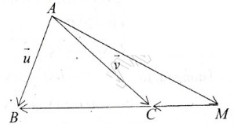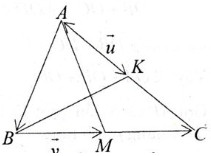cho một tam giác ABC có trung tuyến AM . Lấy K thuộc AC sao cho AK = 1/3 AC. I là trung điểm AM .
a, phân tích 2 vectơ BK và BI theo 2 vectơ \(\overrightarrow{a}=\overrightarrow{BA},\overrightarrow{b}=\overrightarrow{BC}\)
b, chưngs minh B,I,K thẳng hàng











 = 3
= 3 =>
=>  )
) =
= 
 -
-  nên
nên  =
= 

 +
+ 



 =
= 
 =>
=> 
 = -
= - = -
= - = -
= -
 =
=  = 2
= 2
 = -
= - +
+  = 2
= 2

